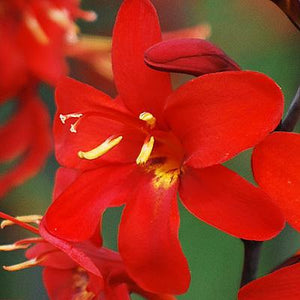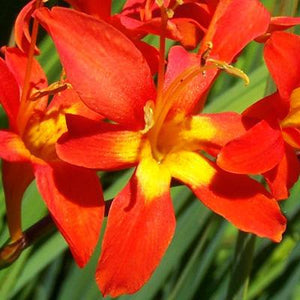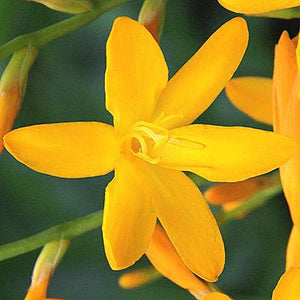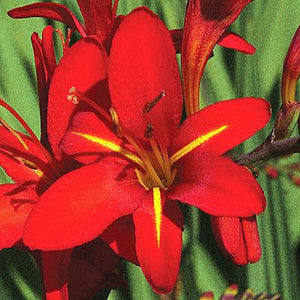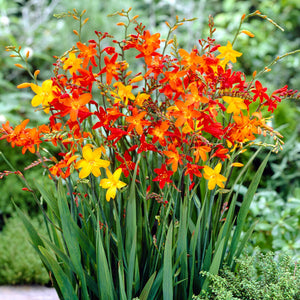- Home
- Planting Guides
- Crocosmia Planting & Growing Guide
Crocosmia Planting & Growing Guide
A member of the Iris family, Crocosmia produces brilliantly colored, exotic-looking, tubular-shaped flowers that branch out into Freesia-like flower spikes. They're living magnets for hummingbirds and pollinators, super easy to grow, and known to steadily bloom from mid-summer through mid-fall above decorative clumps of erect, sword-shaped leaves. Often regarded as the most colorful flowers in the world, these beauties arrive in vibrant shades of fiery scarlet, red, orange, and yellow. So, are you ready to embark on a gardening journey with Crocosmia? We'll even make it easy for you with this comprehensive guide!
Success Snapshot
PLANTING
DEPTH
3"

WATER
QUANTITY
Moderate
SUNLIGHT
QUANTITY
Full to Partial Sun
PLANTING
PROXIMITY
6-8" Apart
BLOOM
SEASON
Late Spring to Summer
HARDINESS
ZONES
Zones 6-10
Shop Related Products
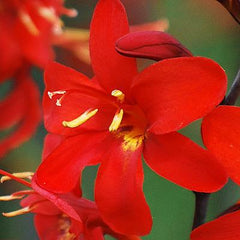
Crocosmia - Erika
$7.95
Contains: 20 Crocosmia corms
Botanical Name: Crocosmia 'Erika™'
Exposure: Full Sun to Partial Sun
Hardiness: Zones 6-10
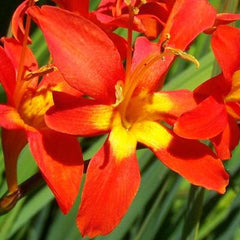
Crocosmia - Jochem
$7.95
Contains: 20 Crocosmia corms
Botanical Name: Crocosmia 'Jochem™'
Exposure: Full Sun to Partial Sun
Hardiness: Zones 6-10

Crocosmia - George Davison
$7.95
Contains: 20 Crocosmia corms
Botanical Name: Crocosmia crocosmiiflora 'George Davison'
Exposure: Full Sun to Partial Sun
Hardiness: Zones 6-10
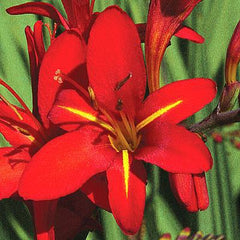
Crocosmia - Vera Cruz
$7.95
Contains: 20 Crocosmia corms
Botanical Name: Crocosmia 'Vera Cruz™'
Exposure: Full Sun to Partial Sun
Hardiness: Zones 6-10

Crocosmia - Red Hot Mix
$7.95
Contains: 20 Crocosmia corms, mixed colors.
Botanical Name: Crocosmia
Exposure: Full Sun to Partial Sun
Hardiness: Zones 6-10
Where to Plant
Crocosmia is an easy grower that multiplies readily and tolerates both ground and container plantings as long as they receive plenty of sun and have well-draining soil. If you notice water puddles 5–6 hours after a hard rain, you'll want to find another site or amend the soil with the addition of organic material to improve drainage. These beauties are also remarkably tough when it comes to winter temperatures, weathering zone 5 or zone 6 chills, depending on the variety.
When to Plant
Plant your Crocosmia corms in the spring after the danger of frost has passed. If the weather conditions are still chilly or the soil temperature is cold, hold off planting until the soil has warmed up.
How to Plant
- For container planting, select a container with adequate drainage holes and fill it with good quality, well-draining soil. Almost any commercially available potting mix will do the trick.
- For outdoor landscape planting, select a spot with well-drained soil where your Crocosmia corms will receive full to partial sunlight.
- Dig holes and plant the corms 3" deep and 6–8" apart with the pointy ends facing up.
- Water thoroughly after planting, gently soaking the soil to settle it around the corms.
How to Grow
- Water as needed during active growth.
- Leave the foliage in place after blooming has finished for the season. The leaves will gather sunlight and provide nourishment for next year's show.
- Remove the leaves once they turn yellow and begin to wilt.
- Allow your Crocosmia to rest for a few months after flowering has finished before beginning the next growing cycle.
Crocosmia Tips & Tricks
- Create a fabulous summer bouquet by snipping some of these beautiful blooms.
- Prepare for hungry birds to grace your garden in droves as the blossoms give way to seedpods in the fall.
- Amend the soil as needed with organic material to raise the level 2–3" and improve drainage as Crocosmia will not thrive in soggy settings. Compost, ground bark, or decomposed manure all work a charm and are widely available.
- Expect roots and sprouts to form in a few weeks, depending on soil and air temperatures. Crocosmia requires heat to get going and can be slow to sprout.
- Mix Crocosmia corms with other plants in the same container, just keep in mind that all must have the same light and water needs.
- Feel free to cut the flowers while in bloom for stunning bouquets, as doing so will not hurt the plant. The arched sprays add colorful highlights and varied flower forms to arrangements.

